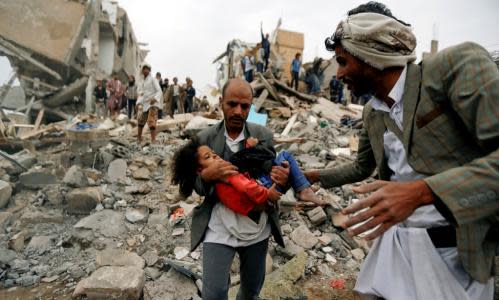US-made bomb killed civilians in Yemen residential building, says Amnesty

A bomb that destroyed a residential building in Yemen’s capital last month, killing 16 civilians and injuring 17 more – including a five-year-old girl called Buthaina whose photograph went viral after the strike – was made in the US, Amnesty International has said.
The assessment was based on an examination of the remnants of the weapon used in the 25 August airstrike.
The Saudi Arabia-led military coalition admitted carrying out the attack, blaming civilian casualties on a “technical error”.
Lynn Maalouf, Amnesty International’s Middle East research director, said: “We can now conclusively say that the bomb that killed Buthaina’s parents and siblings, and other civilians, was made in the USA.
“There simply is no explanation the USA or other countries such as the UK and France can give to justify the continued flow of weapons to the Saudi Arabia-led coalition for use in the conflict in Yemen. It has time and time again committed serious violations of international law, including war crimes, over the past 30 months, with devastating consequences for the civilian population.”
The controversy comes as some EU countries, in concert with Canada, again table a motion at the UN human rights council in Geneva calling for an independent UN inquiry into the conduct of the war, and human rights abuses committed by all sides in the conflict. A similar motion was put to the council in 2015 and 2016, and either rejected or water down.
The latest motion, due to be voted on next week, does not have the support of the Arab League or some key EU countries, including the UK, but it is known that Britain thinks diplomatic efforts to bring about peace in the two-year civil war in Yemen have reached a kind of deadlock, and need rethinking.
Earlier this month, the UN high commissioner for human rights, Zeid Ra’ad al-Hussein, called the humanitarian crisis in Yemen an “entirely man-made catastrophe”. He continued: “The reticence of the international community in demanding justice for the victims of the conflict in Yemen is shameful, and in many ways contributing to the continuing horror.”
On 19 September, the UK Ministry of Defence announced a new military and security cooperation agreement with Saudi Arabia. The defence secretary, Sir Michael Fallon, said the agreement “further cements the UK’s longstanding relationship with our key Gulf partner”.
Although the UK has expressed concern about the Saudi conduct of the war, the high court earlier this year found the UK government’s granting of arms sales licences to the British arms manufacturers selling to Saudi was lawful. British officials also believe the Saudis have been overall more sophisticated in their targeting, and more willing to admit mistakes following internal investigations.
The total number of civilian casualties in Yemen since March 2015 stands at 13,920, including 5,159 people killed and 8,761 injured.

 Yahoo News
Yahoo News 